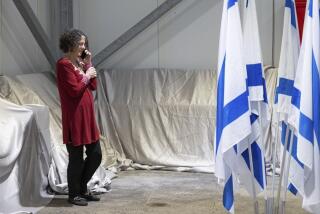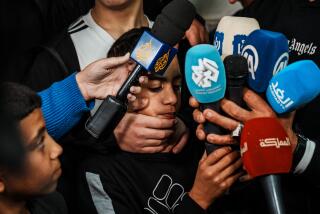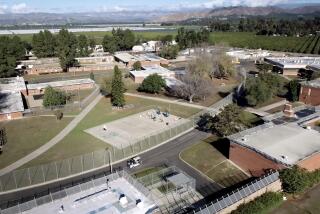Militants use children to do battle in Iraq
baghdad -- Child fighters, once a rare presence on Iraq’s battlefields, are playing a significant and growing role in kidnappings, killings and roadside bombings in the country, U.S. military officials say.
Boys, some as young as 11, now outnumber foreign fighters at U.S. detention camps in Iraq. Since March, their numbers have risen to 800 from 100, said Maj. Gen. Douglas Stone, the commander of detainee operations. The Times reported last month that only 130 non-Iraqi fighters were in U.S. custody in Iraq.
Stone attributes the rise in child fighters in the country, in part, to the pressure that the U.S. buildup of troops has placed on the flow of foreign fighters.
Fewer of them are making it into the country, he said, and the militant group Al Qaeda in Iraq is having a difficult time recruiting adults locally. Thus, it has turned to children.
“As our operations have increased, Al Qaeda [in Iraq] and others have used more minors in the fight against us, and in the process we have detained more and more juveniles,” Stone said.
He said the children make effective fighters because they are easily influenced, don’t experience fear in the same way as adults and don’t draw as much scrutiny from U.S. forces.
Other causes for the increase in detentions may be that U.S. forces are simply coming into contact with more children because of the troop buildup, and that financial pressures may have pushed some Iraqi families toward the militants.
Stone said some children have told interrogators that their parents encouraged them to do the militants’ dirty work because the extremists have deep pockets.
Insurgents typically pay the boys $200 to $300 to plant a bomb, enough to support a family for two or three months, say their Iraqi instructors at a U.S. rehabilitation center.
About 85% of the child detainees are Sunni and the majority live in Sunni Arab-dominated regions in the country’s west and north. In these deeply impoverished, violence-torn communities, the men with money and influence are the ones with the most powerful arsenals. These are the children’s role models.
The rise of child fighters will eventually make the Iraq conflict more gruesome, said Peter W. Singer, a Brookings Institution expert on child fighters.
He said militant leaders often treat children as a cheap commodity, and peace will be less attainable because “conflict entrepreneurs” now have an established and pliable fighting force in their communities.
Websites feature stories of child martyrs as an inspiration, and on the other side of the sectarian divide, radical Shiite Muslim cleric Muqtada Sadr’s Mahdi Army also boasts of youngsters’ involvement.
“This shows that the Mahdi are a popular resistance movement against the occupiers. The old men and the young men are on the same field of battle,” Sadr spokesman Sheik Ahmad Shebani told the London Daily Telegraph.
The boys are arrested under a wide range of circumstances, and their commitment to insurgents is believed to vary greatly.
Although some of their alleged offenses include kidnappings and killings, the vast majority are held for allegedly planting bombs in the road in exchange for money, authorities said.
The rise in young fighters compounds the savagery that has already shuttered many schools, left children wounded and hungry, and killed parents before children’s eyes.
For their American captors, the apparent surge of child fighters confuses enemy and friend on the battlefield even further, and it causes renewed scrutiny of the military’s detention policies and lack of judicial access for juvenile detainees in custody.
To accommodate the influx of boys, and to break the hold of the militants, a new education facility opened here Aug. 13.
It sits a bus ride away from Camp Cropper, the U.S. detention area where the boys, between the ages of 11 and 17, live segregated from many others of the estimated 24,000 suspected insurgents in American custody in Iraq.
The new education center replaces Camp Cropper’s one-room schoolhouse and accommodates all but 100 who are ineligible for school because they are severely developmentally disabled, ill or too militant.
The students, a quarter of whom are illiterate, study basic Arabic, English, math, geography and science in air-conditioned tent classrooms. Dubbed the House of Wisdom, the classrooms are surrounded by concrete walls topped with razor wire.
In daily civics lessons, the boys study Iraqi history and new government institutions. A team of psychiatrists will provide regular counseling. A large library will hold 4,000 volumes and already has English textbooks, computer manuals and a set of Harry Potter books translated into Arabic.
“We have quickly realized,” Stone said during an interview at the new site, “that most of these young men are victims not only of Al Qaeda [in Iraq], but also of their own illiteracy. Because they couldn’t read or write, they also couldn’t work, and unemployed young men are also angry young men, susceptible to the cunning arguments of extremists.”
In classroom A5, a Times reporter was allowed to observe the children, but not ask them questions. An Iraqi teacher with khaki trousers and sunglasses perched over his baseball cap led an Arabic lesson for about 30 boys.
“Who wants to read?” he asked. Hands rose across the room.
The teacher chose a boy in the back row with his hair slicked back and asked him to choose a story.
The boy thumbed through the book carefully, settling finally on a story about a narrator who finds a captive, abused cat and decides to feed, water and release it.
“It’s about freedom,” the boy said.
The boys sat in a classroom decorated with their crayon drawings of houses, flowers and palm trees. An Iraqi flag was pinned to the plywood wall, and a pile of prayer rugs was neatly stacked on a white plastic chair.
The facility expands rehabilitation efforts at previous detention sites for children at Abu Ghraib prison in Baghdad, where the Red Cross complained that children suffered improperly harsh treatment, and Camp Iguana at Guantanamo Bay, Cuba, where only children 16 and younger typically have been segregated from adults. Abu Ghraib has since been handed over to the Iraqi government, and the detainees have been transferred to Camp Cropper.
“Establishing this type of facility,” Singer said, “sends a message to the American people and the world that we are not doing evil deeds to these children. . . . But telling these detainees that we are going to treat you well and you will read Harry Potter still doesn’t resonate with someone who says, ‘I want to die killing you.’ ”
Some of the boys write the name of a militant leader across their prison uniforms, telling the guards it is the name of a parent or loved one, said Kareem, an Iraqi American who acts as a counselor to the boys and asked that his surname not be used.
Adult detainees try to instigate the minors by wrapping notes around stones and tossing them over the wall at their sleeping quarters or by calling out to them. The message they send is that the teachers and guards are infidels who will try to convert them to Christianity, Kareem said.
Clashes between sects led to segregation of Sunni and Shiite detainees in their sleeping quarters, but they still study, play and eat together.
In December, guards at Camp Cropper put down a riot when about 240 boys ripped toilets from the floor and hurled stones and concrete, said 1st Lt. Rob Glenn, the juvenile education administrator.
Stone acknowledged that the child detainees at Camp Cropper include a growing number of hardened Islamic extremists, and he said he worried about the influence they have over other youth, some of whom say they committed their alleged crimes under coercion.
Last month, for instance, soldiers stopped a 13-year-old boy carrying a homemade bomb on his bicycle. The boy told his interrogators that Al Qaeda in Iraq militants had kidnapped his mother and sister and forced him to do the job, said Col. Paul Funk, commander of the U.S. Army’s 1st Brigade, 1st Cavalry Division.
In such cases, the military often asks the boy’s tribal leader whether he believes the child had been coerced and whether the leader will assume responsibility for his future actions. In this case, the sheik said the boy was a criminal, so he was detained, Funk said.
Hicham Hassan, spokesman for the Red Cross and monitor for American detention facilities, said his agency has filed a formal complaint with the military regarding the denial of access to an attorney and the courts. The military holds the boys for up to a year before they are released or forwarded to the Iraqi judicial system for trial.
The use of children by the militants has some precedent in the regime of Saddam Hussein, who used the organization Ashbal Saddam -- Saddam’s Lion Cubs -- as a paramilitary force of boys between 10 and 15 that fed the fedayeen units led by his son Uday.
The remnants of the fedayeen make up one of the insurgent forces fighting today, and in at least three Iraqi cities, children reportedly took aim at U.S. troops during the 2003 invasion.
Stone believes that just as boys can be trained to become militants, they can be rehabilitated. A Christian, the major general reads the Koran daily to help his efforts to give the boys the tools to question the militancy they have been taught.
Some signs indicate that by isolating the boys from extremists, progress can be made.
Early drawings by some of the boys showed pictures of masked gunmen defeating Iraqi soldiers. In later drawings, the masked gunmen were the losers.
--
Special correspondent Mohammed Rasheed contributed to this report.
More to Read
Sign up for Essential California
The most important California stories and recommendations in your inbox every morning.
You may occasionally receive promotional content from the Los Angeles Times.











